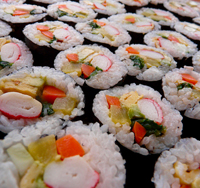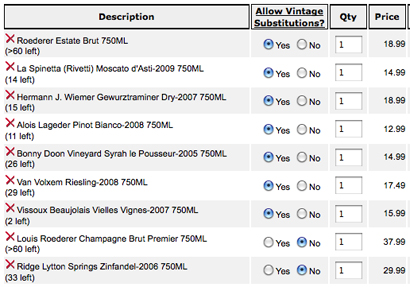BREAKING: Korean feast not impossible with wine!
 Not intimidated by the Herculean challenge of pairing wine and Korean food, I selected a range of wines for a Korean new year feast last week.
Not intimidated by the Herculean challenge of pairing wine and Korean food, I selected a range of wines for a Korean new year feast last week.
The “impossibility” of the pairing centers on two things: 1) kimchi and spices and 2) a culture clash that came up in our previous discussion about whether wine (and alcohol) should be seen as a complement to the food or as a “palate cleanser,” a role that the high-octane soju often performs at Korean feasts.
Playing sommelier for the evening, I selected a range of wines including bubblies, aromatic whites, and some reds. The actual selection is often limited by the practical consideration of which wines you can actually find in your market. I chose the wines from Garnet Wine & Liquors, a store near the residence of the repast. Here’s a copy of the order:

Unfortunately, we didn’t get a chance to try all the wines (there were only 14 people). We started off with the two bubblies, both from Roederer but one from California’s Anderson Valley and the other from Champagne, as a way to highlight the differences between the two regions. Paired with the dumplings, they both were good and popular but I preferred the cut of the Champagne. It also worked well with the jeon later in the meal, I found.
Moving to the table, we had a smorgasbord of Korean delights. I poured the aromatic whites and the Hermann J. Wiemer pleasantly surprised people who were programmed not to like either gewurztraminer or New York wines. The Van Volxem riesling fro the Saar was a big hit. I also brought a Lucien Crochet Sancerre to try the acid/mineral pairing and although the wine itself was good enough, it kind of bombed with the food (I should have tried it with the kimbap though).
The fruit and acidity of Pierre Chermette Beaujolais Vielles Vignes worked well. By the time the grilled beef bulgoki came out, so did Bonny Doon Le Pousseur syrah and the Ridge Lytton Springs zinfandel. I had chosen these on the “palate cleanser” end of things but the syrah seemed overshadowed while the zin was impressive and quite popular. In the end, I even tried a soju and it wasn’t as frightening as I had feared!
Thanks to some suggestions on the previous thread, our hosts even had some delicate white kimchi (baek), which was quite delicious on its own. I think I had already had the soju at this point so forgot to pair with wine…
Anyway, Korean food may have some challenges for wine pairing but they can be overcome! We had fun and I look forward to more experimenting of this kind in the future. Give it a try because even if you are a wine geek who still feels it is impossible, then there’s always the fallback: drink first, eat later.




On February 22nd, 2010 at 2:14 pm ,bob rohden wrote:
Dr.
I have found that with some Asian food styles it is a nice idea to try the French-American hybrid wines such as Seyval and Vidal Blancs; fruit wines like Apricot, Peach, Cherry; the newer Midwest varietals, Chardonel, Traminette, St. Croix; and the native Cayuga, Catawba, Frontenac, deChaunac.
On February 24th, 2010 at 3:29 am ,Banchan: Wine and Korean Food | ZenKimchi Korean Food Journal wrote:
[…] Vino wonders if Korean food is impossible to pair with wine and then is surprised. Obviously hasn’t read much Josh […]
On February 24th, 2010 at 3:40 pm ,Mary Cressler wrote:
Nice insight! I have a restaurant client and my task is to help him pair Japanese cuisine with wine. I’ve found very few resources on pairing various Asian cuisines with wines (other than sparkling and sweet). I love reading all I can about the subject. Looking forward to reading about new things you discover. Cheers
On February 25th, 2010 at 8:29 am ,boerinballingskap wrote:
As a resident of Korea and a lover of wine, I found this post very interesting. I must say that Korean food doesn’t easily lend itself to wine pairing. But with the proper experimentation, as you have shown, it is not impossible. I have found that some Rieslings (with some oily character and slightly sweet) does do wonders. Lighter reds as well and bubbly. Whatever one chooses, it remains an interesting journey!
On February 27th, 2010 at 2:58 pm ,Hoonill wrote:
As a wine lover and a korean which is living in US, I enjoyed your article pretty much. Since late 1990’s or early 2000s’, wine has become popular in Korea, eventhough it is not as popular as other traditionally popular alocohols like soju, beer, and whiskies. Anyhow, to many koreans who are more seriously indulged in wine, wine pairing with korean foods has been very interesting and controversal issue. I have tried several pairing between korean foods and wines and discovered a few potentially well matched pairs
such as sauvignong blanc and korean pancake(aka bouchimgae). In this paring, wine might act as just a “palate cleanser” as you said. As you know,originally, korean foods have not been developed as partners with wine, of course, and vice a versa. So, in some point, the suspicion to wine and korean food pairing is natural.However, it means that there are huge potential to discover awesome wine-food matchs. Isn’t it intrigueing?
Best regards
Hoonill
On March 4th, 2010 at 11:12 am ,Samk wrote:
I’ve been lurking on your blog time to time, but this time I feel compelled to comment because the subject is on my native cuisine 😉 And yes, you’re right, the notion that Korean cannot be paired with wine is a myth, completely.
Some very good choices, I must say. If it were up to me I would have gone with Champagne (or prosecco), riesling and gewurztraminer for whites, and syrah and zinfandel for reds also. For some of the more delicate dishes, such as kimbap or jeon, pinot gris or chenin blanc would go well too, I think. And I think bulgogi screams for amarone (well, bulgogi is similar to braised beef in some ways, no?), but that might just be me. The real challenge is finding a red wine to go with kimchi, but I’ve heard that gaglioppo, a Calabrian grape, works quite nicely.
By the way, there’s so much more to traditional Korean liquors than soju. I think soju is vile, and I don’t touch that stuff unless I have to. The only reason soju has become popular in Korea is that it’s dirt cheap, about $1 for a bottle, and the reason Korean expats seek it out is because of sentimental values. On the other hand traditionally brewed soju made from rice, as opposed to mass market soju which is diluted grain alcohol distilled from tapioca, can compete with any sake in delicacy and complexity, and other traditional rice or herbal liquors can be pretty fabulous also. But people just don’t go out to try these thngs, and none of them are available outside Korea. I think it’s a crying shame.
On March 6th, 2010 at 2:34 pm ,Carl (Byersantis) wrote:
Hi There:
This blog was great! I am totally up for trying different foods with wine. Sometimes Sometimes people get caught up with what wine goes with what food…..Why? I think that wine and food pairing should be simple. Drink the wine that YOU think compliments your meal. It’s an adventure, not a set of rules!
On March 15th, 2010 at 11:17 am ,ConstanceC wrote:
you forgot the gruner!
On March 14th, 2011 at 4:46 pm ,michelle park wrote:
Hey tyler – i was at the most recent dinner wiht the kims — im looking for the name of the herbal infused wine that you we had with the bbq? can you let me know?
thanks!
Michelle